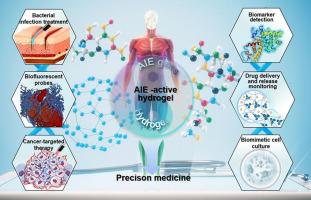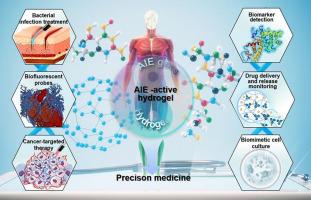Synergizing AIE Luminogens and hydrogel matrices: Advancing precision medicine through smart material design
IF 23.5
1区 化学
Q1 CHEMISTRY, INORGANIC & NUCLEAR
引用次数: 0
Abstract
The integration of aggregation-induced emission (AIE) luminogens (AIEgens) with hydrogel materials has significantly expanded their applications in precision medicine, fostering groundbreaking innovations in biomedicine. AIEgens exhibit exceptional photostability, a high signal-to-noise ratio, and stimuli-responsive properties making them uniquely suited for constructing theranostic platforms for image-guided diagnosis and therapy. Meanwhile, hydrogels provide an ideal matrix for precision diagnostics and therapeutics due to their outstanding biocompatibility, tunable physicochemical properties, and capacity to serve as carriers for drugs and molecular probes. Given the immense potential of AIEgen-hydrogel composite systems in precision medicine, this review systematically summarizes recent advances in their applications, including cancer-targeted therapy, biofluorescent probes, antibacterial treatment, biomimetic cell culture, biomarker detection, and drug delivery/release monitoring. Furthermore, we critically analyze the key challenges hindering their widespread adoption and discuss future research directions. Together, AIEgen-integrated hydrogel systems represent a transformative approach in precision medicine, driving significant progress through their versatile biomedical functionalities.


协同AIE发光原和水凝胶基质:通过智能材料设计推进精准医疗
聚集诱导发射(AIE)发光原(AIEgens)与水凝胶材料的结合,极大地扩展了其在精准医疗领域的应用,促进了生物医学领域的突破性创新。AIEgens具有出色的光稳定性,高信噪比和刺激响应特性,使其独特适合于构建用于图像引导诊断和治疗的治疗平台。同时,水凝胶由于其出色的生物相容性、可调节的物理化学性质以及作为药物和分子探针载体的能力,为精确诊断和治疗提供了理想的基质。鉴于aiogen -水凝胶复合系统在精准医疗领域的巨大潜力,本文系统总结了其在癌症靶向治疗、生物荧光探针、抗菌治疗、仿生细胞培养、生物标志物检测和药物传递/释放监测等方面的最新应用进展。此外,我们批判性地分析了阻碍其广泛采用的关键挑战,并讨论了未来的研究方向。总之,aigen集成水凝胶系统代表了精准医学的变革方法,通过其多功能生物医学功能推动了重大进展。
本文章由计算机程序翻译,如有差异,请以英文原文为准。
求助全文
约1分钟内获得全文
求助全文
来源期刊

Coordination Chemistry Reviews
化学-无机化学与核化学
CiteScore
34.30
自引率
5.30%
发文量
457
审稿时长
54 days
期刊介绍:
Coordination Chemistry Reviews offers rapid publication of review articles on current and significant topics in coordination chemistry, encompassing organometallic, supramolecular, theoretical, and bioinorganic chemistry. It also covers catalysis, materials chemistry, and metal-organic frameworks from a coordination chemistry perspective. Reviews summarize recent developments or discuss specific techniques, welcoming contributions from both established and emerging researchers.
The journal releases special issues on timely subjects, including those featuring contributions from specific regions or conferences. Occasional full-length book articles are also featured. Additionally, special volumes cover annual reviews of main group chemistry, transition metal group chemistry, and organometallic chemistry. These comprehensive reviews are vital resources for those engaged in coordination chemistry, further establishing Coordination Chemistry Reviews as a hub for insightful surveys in inorganic and physical inorganic chemistry.
 求助内容:
求助内容: 应助结果提醒方式:
应助结果提醒方式:


